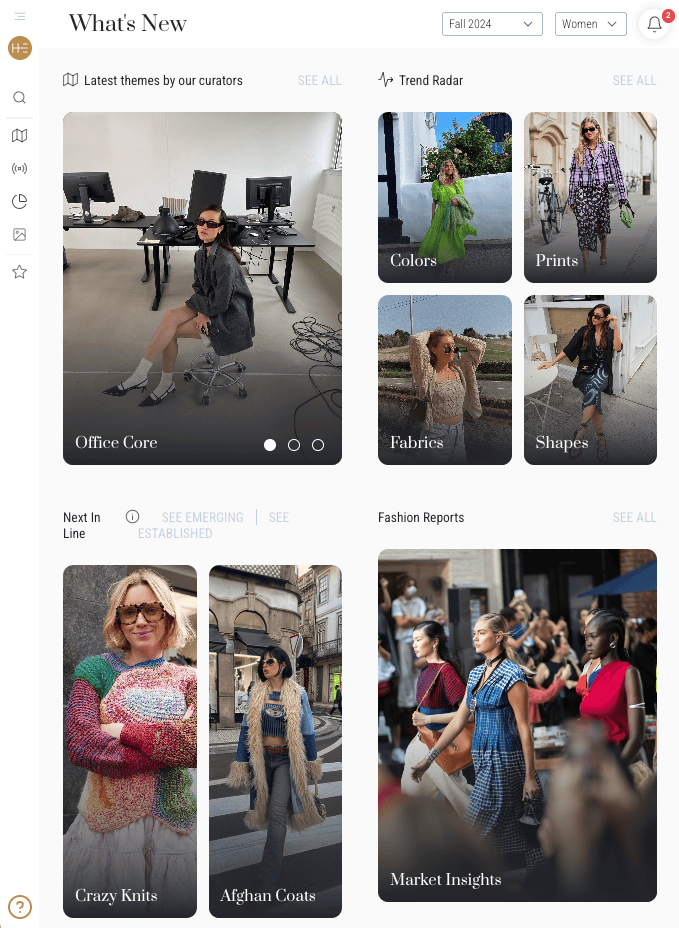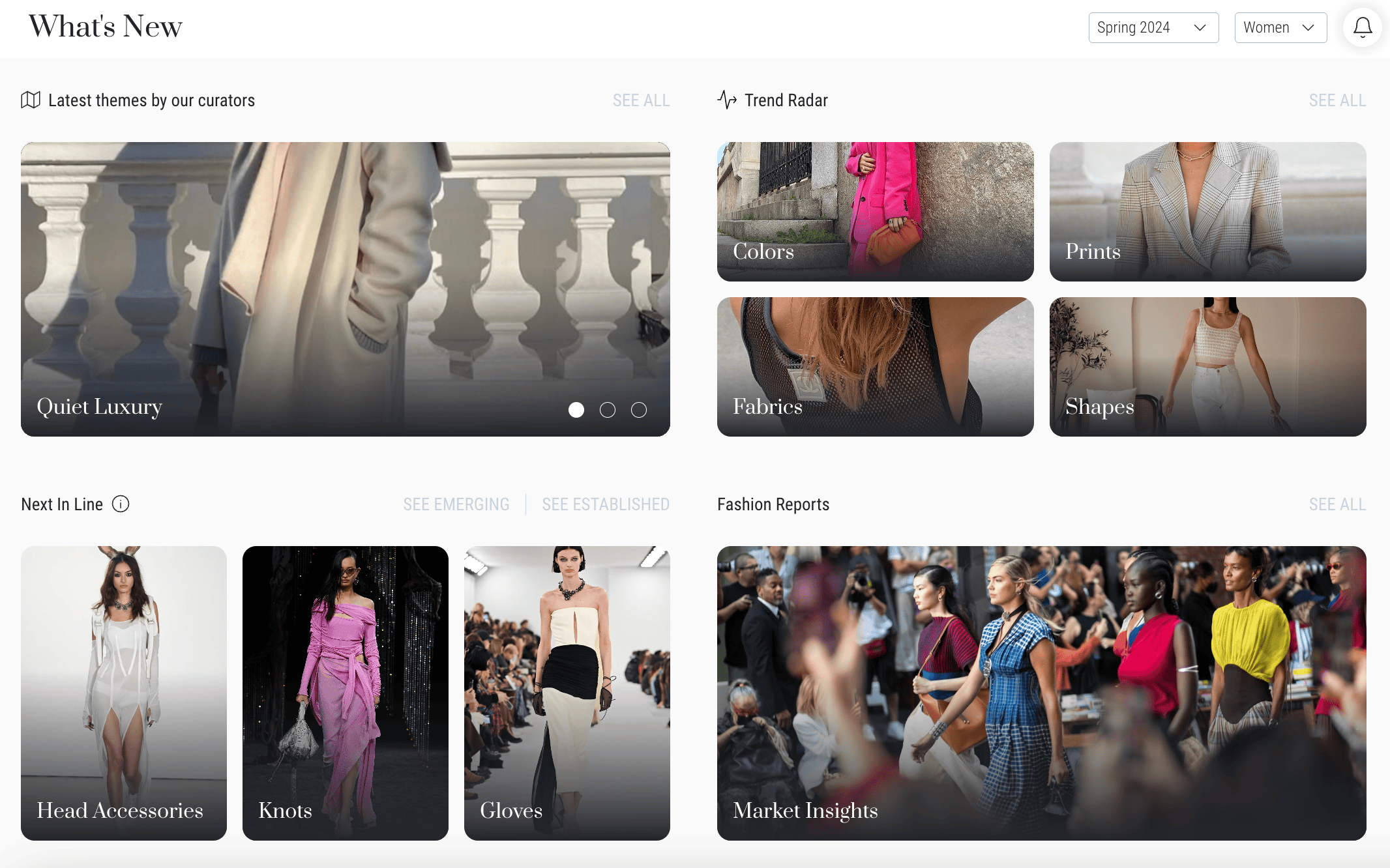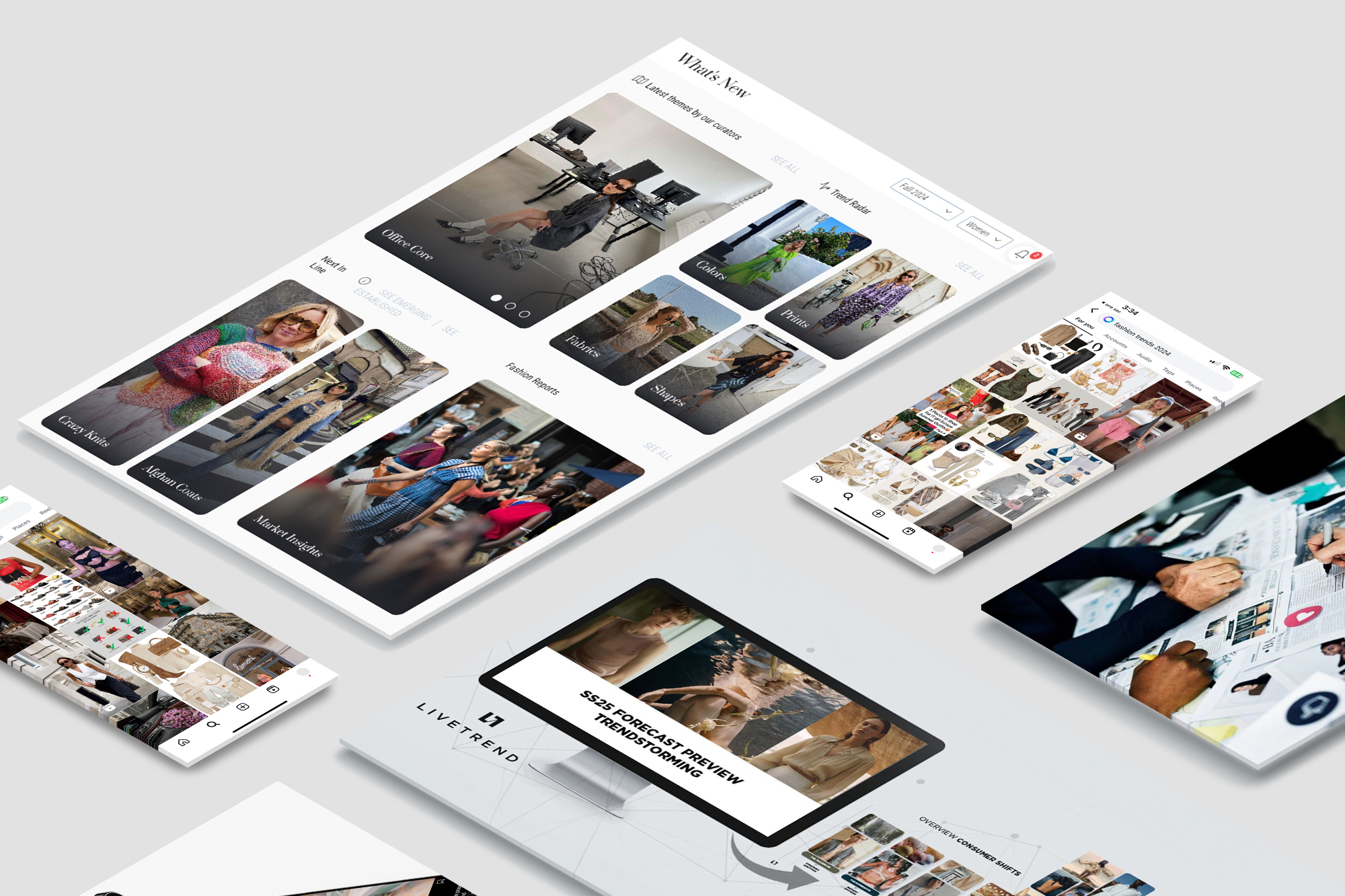How AI Redefines Trend Forecasting: Beyond Prediction to Strategic Innovation
By Lizzy Bowring
Trend Forecasting is no longer a creative approach to predicting the future; it has become a strategic and formulaic process. Imagine trend forecasting as simply akin to peering into a crystal ball, consulting a soothsayer to forecast what’s new, what’s next, or even the best-selling colors and materials for the next six months, one year, or up to ten years from now. Or based on the now, ‘Will bohemian styles dominate next spring?’ might yield a definitive ‘Yes.’ It’s more complex. Predicting fashion trends involves an interplay between creative instinct and precise analytics. This intricate practice, essential for planning for the future in any creative sphere, has evolved from an exclusive domain led by seasoned fashion insiders to a dynamic field influenced by digital trendsetters, influencers, and fast-moving social media trends.
Trend forecasting merges the analytical with the intuitive, predicting future trends by analyzing behaviors across various industries. It combines rigorous data analytics with creative intuition to anticipate cultural, consumer behavior, and technology shifts. This blend of “maths” and “magic” transforms trend forecasting into a precise science that balances creativity with data-driven decision-making.

The real value of incorporating AI into trend forecasting lies in its ability to distill vast amounts of information into actionable insights. Since 2021, AI has transformed trend forecasting, enabling brands to quickly discern between ephemeral fads and lasting trends. AI tools analyze large datasets, providing precise insights that enhance decision-making, gauge consumer preferences, and predict demand shifts in real time.
Artificial Intelligence is a transformative force that is reshaping the future of the Design industry landscape. In particular, it is strategically reimagining trend forecasting. Despite AI’s prowess, the irreplaceable human touch remains crucial in trend forecasting. The fashion industry’s emotional and aesthetic nature poses unique challenges that pure data analysis can only partially address. Integrating AI’s data results with deep industry knowledge and creative insights allows experts to focus on strategic activities, ensuring forecasts resonate with both current circumstances and future possibilities.
The Impression takes a deep dive into the unique osmosis of AI’s sophisticated capabilities, exploring how it will influence the Future of Trend Forecasting and how the workforce is adapting to leverage this tool.
The Benefits of Tapping into AI
The real value of incorporating AI into trend forecasting lies in its ability to distill vast amounts of information into actionable insights. AI has transformed trend forecasting, enabling brands to quickly discern between fleeting fads and lasting trends. Platforms like Livetrend, WGSN, Heuritech, and Seymour Powell use AI to analyze large datasets, providing precise insights that enhance decision-making.
Key Benefits of AI in Trend Forecasting:
- Rapid Data Analysis: AI tools can scan thousands of runway images in moments, extracting key trends in color palettes, fabrics, and designs, allowing designers to adapt collections swiftly and freeing up creative time.
- Consumer Preference Insights: By analyzing global data, AI identifies diverse consumer preferences across demographics, enriching the design process and ensuring collections reflect a comprehensive array of tastes.
- Social Media and Consumer Feedback: AI models analyze millions of images and social media posts daily, helping brands gauge which products will resonate with consumers. This real-time insight is crucial as trends can shift dramatically from one season to the next.
- Predictive Accuracy: AI aids in understanding trends through clickstream data and tracking online searches, identifying rising trends before they peak. This foresight enables strategic inventory management and reduces textile waste by aligning production with expected demand.
Barbara Maioccho, CEO of Livetrend, highlights AI’s transformative role: “AI-enhanced forecasting predicts trends more accurately, helping brands find the most relevant trends in the fast-paced digital world.” With a 93% reliability rate, Livetrend AI provides highly reliable information, striking the right balance between market trends and consumer appeal.

While AI dramatically enhances data processing capabilities, the synergy between AI and human creativity is essential. Human experts interpret the nuanced cultural and emotional factors that AI might overlook, ensuring forecasts are both data-driven and deeply contextual. This combination is vital for creating actionable strategies that resonate with consumers and provide competitive advantages in a rapidly evolving marketplace.
The Future of AI in Trend Forecasting
Looking ahead, the transformative power of AI in trend forecasting is immense. AI tools provide quantitative backing to the qualitative insights of seasoned forecasters, empowering brands to anticipate and react to consumer desires with unprecedented speed and accuracy. This ensures a competitive advantage in a rapidly evolving market and opens new avenues for innovation and growth.

A prime example of this transformative power is Heuritech, a pioneer in AI-driven trend forecasting. Founded in 2013 by machine learning experts Tony Pinville and Charles Ollion, Heuritech utilizes proprietary image recognition technology to analyze around three million fashion images on social media daily. By focusing on elements like color, texture, and silhouette, Heuritech categorizes trends by geography and seasonal popularity, providing brands with detailed insights into emerging styles. Their approach, which segments data into ‘edgy,’ ‘trendy,’ and ‘mainstream’ consumer panels, allows brands like Dior, Rabanne, Prada, Louis Vuitton, and New Balance to capture early signals of upcoming trends and strategically shape their collections.
With machine learning you can predictably know where to take up to 80% of your collection. You’re left with 20% of the collection to know what you can innovate. There’s now so much more white space for the design team to be more creative.
– Brad Lacey, Vice President of Design-Lifestyle Footwear
As technology progresses, trend analysis methodologies will evolve, promising even more precise forecasting tools. Future developments may introduce advanced predictive models incorporating a broader range of variables, from environmental impacts to political changes, offering a more holistic view of the future. By understanding the scope and potential of trend forecasting, businesses can strategically position themselves to capitalize on upcoming trends and navigate the complexities of the global market.


A recent McKinsey survey revealed that most fashion executives (73%) consider General AI (GenAI) a key business priority in the coming year. Furthermore, McKinsey’s “Unlocking the Future of Fashion” report forecasts that over the next three to five years, GenAI could boost the operating profits of the apparel, fashion, and luxury sectors by an estimated $150 billion to $275 billion.
From an educational perspective, upcoming trend forecasters must understand and utilize AI technologies. AI has become an indispensable resource for trend forecasters, allowing them to analyze and process large amounts of data from various sources, thus identifying new patterns and trends more quickly and effectively. Integrating the knowledge and use of AI technologies into educational programs for future trend forecasting experts is essential to prepare them to tackle the challenges of the modern world successfully.
As AI tools evolve and become more adept at handling complex datasets, the enduring value of human insight ensures that fashion forecasting remains as much an art as it is a science. Human experts’ creativity and cultural savvy are indispensable in translating cold, complex data into vibrant, living fashion trends that resonate with consumers’ lives and values. By addressing ethical considerations and enhancing educational curricula to include AI, the fashion industry can leverage AI’s full potential responsibly and innovatively, ensuring that integrating this technology into fashion forecasting leads to positive and inclusive outcomes for all.

Key Takeaways
The Role of AI in Trend Forecasting: AI has become a transformative force in the design industry, particularly in trend forecasting. It enhances the ability to analyze large datasets, providing actionable insights that help distinguish between fleeting fads and lasting trends.
Benefits of AI Integration: AI tools like Livetrend, WGSN, Heuritech, and Seymour Powell can quickly process vast amounts of data, from runway images to social media posts. This helps brands to predict consumer preferences, streamline design processes, and reduce time-to-market.
AI’s Impact on Consumer Insights and Market Adaptation: AI aids in understanding consumer behaviors and preferences by analyzing social media reactions, online reviews, and shopping patterns. This real-time insight allows brands to adapt quickly to shifting trends and manage inventories strategically.
Future Possibilities: The future of AI in trend forecasting looks promising, with potential advancements in predictive models that incorporate a wider range of variables. This could lead to more precise and holistic forecasting tools that consider environmental, economic, and political factors.
Educational and Ethical Considerations: As AI becomes more embedded in trend forecasting, it is crucial to address ethical considerations such as data privacy and algorithmic biases. Additionally, integrating AI technologies into educational programs will prepare future trend forecasters to leverage these tools effectively.
Strategic and Sustainable Fashion: By aligning production closely with forecasted demand, AI helps mitigate overproduction, a significant issue in the fashion industry. This not only maximizes business outcomes but also enhances sustainability efforts.
